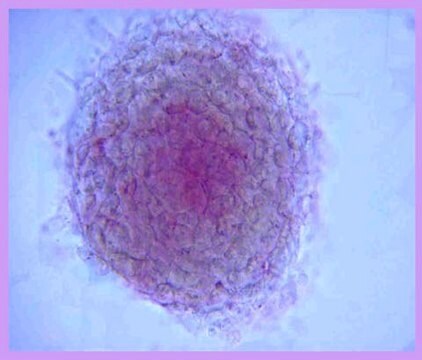SCR066
Quantitative Alkaline Phosphatase ES Characterization Kit
This Quantitative Alkaline Phosphatase Embryonic Stem (ES) Characterization Kit easily quantifies the amount of alkaline phosphatase present within their embryonic stem cell cultures using a convenient 96-well colorimetric enzymatic assay.
About This Item
Polecane produkty
Poziom jakości
reaktywność gatunkowa (przewidywana na podstawie homologii)
mammals
producent / nazwa handlowa
Chemicon®
metody
cell culture | stem cell: suitable
moc wejściowa
sample type: human embryonic stem cell(s)
sample type cardiac stem cell(s)
sample type neural stem cell(s)
sample type hematopoietic stem cell(s)
sample type epithelial cells
sample type mesenchymal stem cell(s)
sample type pancreatic stem cell(s)
sample type: mouse embryonic stem cell(s)
sample type induced pluripotent stem cell(s)
Opis ogólny
Alkaline phosphatase (ALP) is a hydrolase enzyme responsible for dephosphorylating molecules such as nucleotides, proteins, and alkaloids under alkaline conditions. The enzyme is present within all tissues of the body but is elevated in cells of the liver, kidney, bone, placenta, embryo and under specific disease states. Under alkaline conditions (pH>10), ALP can catalyze the hydrolysis of p-nitrophenylphosphate (p-NPP) into phosphate and p-nitrophenol, a yellow colored by-product of the catalytic reaction. The amount of p-nitrophenol produced is proportional to the amount of alkaline phosphatase present within the reaction. The amount of ALP can thus be reliably quantified by reading the amount of p-nitrophenol amassed after the catalytic reaction at 405 nm on a spectrophotometer.
Zastosowanie
Stem Cell Research
Komponenty
p-NPP Buffer: (Part No. ES011-10ML) 10 mL
Reaction Stop Solution: (Part No.CS200653) 5 mL
1X Wash Solution: (Part No. CS200652) 2 X 125 mL
Recombinant Alkaline Phosphatase Standard: (Part No. CS200654) 0.5 μg (10 μg/mL)
Przechowywanie i stabilność
Informacje prawne
Oświadczenie o zrzeczeniu się odpowiedzialności
Hasło ostrzegawcze
Danger
Zwroty wskazujące rodzaj zagrożenia
Zwroty wskazujące środki ostrożności
Klasyfikacja zagrożeń
Aquatic Chronic 3 - Eye Dam. 1 - Met. Corr. 1 - Repr. 2 - Skin Corr. 1B
Kod klasy składowania
8A - Combustible corrosive hazardous materials
Certyfikaty analizy (CoA)
Poszukaj Certyfikaty analizy (CoA), wpisując numer partii/serii produktów. Numery serii i partii można znaleźć na etykiecie produktu po słowach „seria” lub „partia”.
Masz już ten produkt?
Dokumenty związane z niedawno zakupionymi produktami zostały zamieszczone w Bibliotece dokumentów.
Nasz zespół naukowców ma doświadczenie we wszystkich obszarach badań, w tym w naukach przyrodniczych, materiałoznawstwie, syntezie chemicznej, chromatografii, analityce i wielu innych dziedzinach.
Skontaktuj się z zespołem ds. pomocy technicznej









